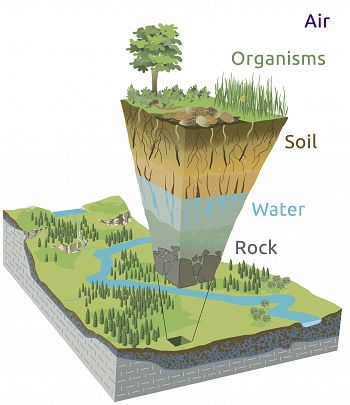Media Kit
Questions from the media should be directed to the National Office Coordinator and/or the PI Committee Chair:
Tim White
CZO National Office Coordinator
Email
See our Contact page for current PI Committee Chair, a position that rotates annually.
Description of the CZO Program
Critical Zone Observatories (CZOs) are natural watershed laboratories for investigating Earth surface processes mediated by fresh water. Research at the CZO scale seeks to understand these little-known coupled processes through monitoring of streams, climate/weather and groundwater. CZOs are instrumented for hydrogeochemical measurements and are sampled for soil, canopy and bedrock materials. CZOs involve teams of cross-disciplinary scientists whose research is motivated and implemented by both field and theoretical approaches, and include substantial education and outreach.
For more information, see the About page and Research page.
Press Releases
For updates and news about CZO, see our News page.
Overview Documents
CZO Brochure (2014, 5 MB PDF)
CZO two-page overviews (2014, 16MB PDF)
CZO Poster (2014, 3 MB PDF)
2012 Article in International Innovation Environment (20 pg, 8 MB PDF) Note: this article discusses 6 observatories in detail. But the program subsequently expanded to 9 observatories.
Image Requests
NonCommercial only - With the exception of CZO graphics and logos, images on criticalzone.org are available for non-commercial use (including educational use). Using an image does not convey CZO’s endorsement.
Attribution required- You must give appropriate attribution to the source of the image. If you make substantial changes to the image, they should be noted too.
For example, this Critical Zone illustration has been substantially changed. The full attribution is "Modified from Chorover, J., R. Kretzschmar, F. Garcia-Pichel, and D. L. Sparks. 2007. Soil biogeochemical processes in the critical zone. Elements 3, 321-326. (artwork by R. Kindlimann) ." If space is limited, then use a short attribution of "After Chorover et al, 2007. Catalina-Jemez CZO." If attribution style requires credit to the illustrator, use "Based on an image by Ralph Kindlimann. Courtesy of Jon Chorover and colleagues, Catalina-Jemez Critical Zone Observatory". Download high-resolution version (new browser tab).
If you cannot find attribution information or are inquiring about a higher resolution version of an image, please contact the Observatory that is using the image. See the "Contact" link in the upper right or lower left of the page on which the image appears.
Privacy - If the image includes an identifiable person in a situation that may infringe that person's right to privacy or publicity, then permission should be obtained from that person in writing. For information about how to correspond with the person in question, get in touch with the Observatory that is using the image. See the "Contact" link in the upper right or lower left of the page on which the image appears.
The Critical Zone. Illustration modified from Chorover, J., R. Kretzschmar, F. Garcia-Pichel, and D. L. Sparks. 2007. Soil biogeochemical processes in the critical zone. Elements 3, 321-326. (artwork by R. Kindlimann). Download high-resolution version (new browser tab)
Associated Files
CZO Brochure (2014)
(5 MB pdf)
A very generalized description of some CZ concepts, including some basic information on the CZOs.
CZO Poster (2014)
(3 MB pdf)
Overview of the program and its' individual observatories
CZO Two-Pagers (2014)
(16 MB pdf)
Two-page overviews of each observatory
Explore Further

